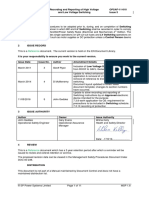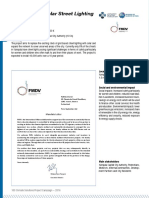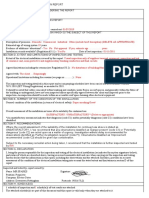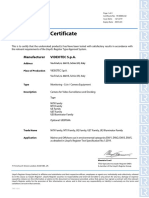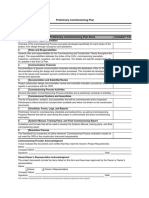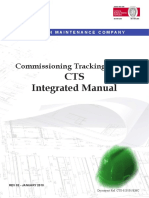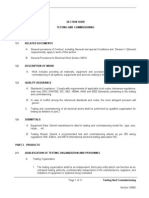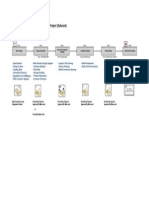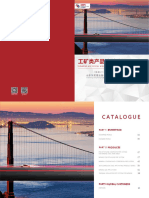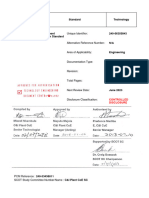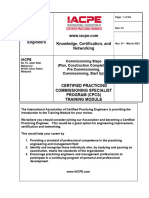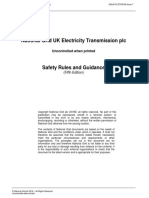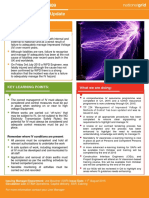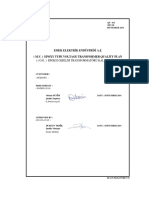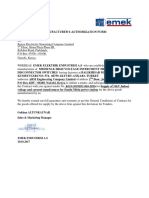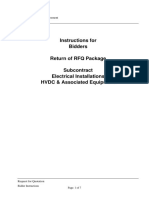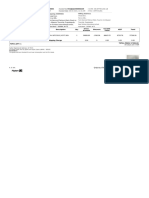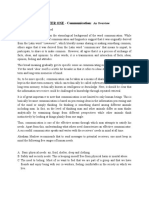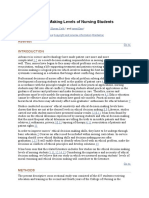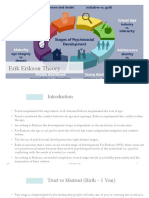Safety Rules Final v3
Uploaded by
S Rao CheepuriSafety Rules Final v3
Uploaded by
S Rao CheepuriSafety
Rules Third Edition Issue 3 2007
National Grid Electricity Transmission
Safety Rules
(Third Edition)
Safety Rules Third Edition Issue 3 2007
DOCUMENT HISTORY
Issue Date Summary of Changes / Author(s) Approved By
Reason (Title)
3 28/12/07 10 year review and Safety Rules Review SHES Standards Manager
update of Safety Rules in Working Group John Duckworth
line with current
legislation / learning
points including current
working practices.
KEY CHANGES
Section Amendments
Page i of ii
Safety Rules Third Edition Issue 3 2007
Contents Page
Introduction 1
Specific Interpretations 2
Statement of Policy, Philosophy and Principles 3
The National Grid Electricity Transmission Safety Rules (Third Edition)
Definitions 5
General Provisions 9
G1 General Safety 9
G2 Safety Rules, Instructions and Procedures 9
G3 Special Instructions 9
G4 Objections on Safety Grounds 9
The Eight Basic Safety Rules 10
R1 Application of Rules 10
R2 Approach to Exposed High Voltage Conductors and Insulators 10
R3 Safety Precautions for Work on or near to High Voltage Equipment 11
R4 Safety Precautions for Work on or near to Low Voltage Equipment 12
R5 Safety Precautions for Work on or near to Mechanical Equipment 13
R6 Operation of Equipment 14
R7 Demarcation of Work Areas 14
R8 Identification of Equipment 14
Safety Document Procedures 15
P1 General 15
P2 Application 15
P3 Safety Precautions 15
P4 Preparation of Safety Documents 15
P5 Issue of Safety Documents 16
P6 Receipt of Safety Documents 16
P7 Additional Work Subsequent to Issue of a Permit for Work 16
P8 Transfer of Safety Documents 17
P9 Clearance of Safety Documents 17
P10 Cancellation of Safety Documents 17
P11 Return to Operational Service 17
P12 Categories of Authorisation 17
P13 Safe Custody of Safety Documents and Associated Items 18
P14 Multiple Safety Documents 18
Form of Documents 19
Page ii of ii
Safety Rules Third Edition Issue 3 2007
Introduction
The National Grid Company Safety Rules are provided to ensure that work can be undertaken safely on or near to
items of Equipment that form part of the System.
The Safety Rules are mandatory. It is the duty of every person who may be concerned with work on or near to the
System to make themselves thoroughly familiar with the detail of the relevant Safety Rules and appropriate
supporting documents. In addition all persons have a general duty to be conversant with and to observe statutory
requirements relating to any activity with which they have an involvement.
It is the responsibility, under the Health and Safety at Work etc. Act 1974, and Regulations made under it, that all
persons employed will take reasonable care for the health and safety of themselves and other persons who may be
affected by their acts or omissions.
The statement of Policy, Philosophy and Principles do not form part of the Safety Rules. It is included for general
information.
Specific Interpretations do not form part of the Safety Rules but are terms used within the rules to reflect Health and
Safety legislation.
Work When used in these Rules the term ‘work’ includes testing and operational and safety switching.
Gender All references in these Rules to the masculine gender shall include the feminine.
Page 1 of 46
Safety Rules Third Edition Issue 3 2007
Specific Interpretations
1 Shall
When ‘shall’ is used in these Rules with no qualification, this indicates a mandatory requirement. No
discretion is permitted and no judgement can be made.
2 Shall, where practicable
When ‘shall, where practicable’ is used to qualify a requirement, a slightly less strict standard is imposed.
It means that where it is possible to achieve, in the light of current knowledge and invention, then the
requirement shall be met. To avoid the requirement on the grounds of difficulty, inconvenience or cost is
not allowed.
3 Shall, where reasonably practicable
When ‘shall, where reasonably practicable’ is used to qualify a requirement, then a judgement shall be
made as to what is reasonable. This shall take into account an assessment of the magnitude of the risk on
the one hand and the cost, time and trouble, and effort necessary for averting the risk on the other hand.
Page 2 of 46
Safety Rules Third Edition Issue 3 2007
Statement of Policy, Philosophy and Principles
1 Policy
1.1 The Company’s “Group Policy Statement on Safety and Occupational Health”, is supported by “A
Safe Way of Working” policy statement. This Policy statement takes account of a widerange of
health and safety legislation under which the businesses within National Grid operate primarily the
Health and Safety at Work Act 1974. It also takes account of standards and best practice
introduced by such businesses to improve safety behaviours.
1.2 The Group Policy Statement makes specific reference to maintaining high standards of safety and
occupational performance. There is a requirement to meet, and where appropriate, exceed the
requirements of health and safety legislation, policies, and other commitments to which National
Grid subscribe. These Rules have been formulated taking into account principally the Electricity at
Work Regulations 1989 and the Management of Health and Safety at Work Regulations 1999.
1.3 The Company recognises and accepts its statutory and moral responsibilities for ensuring our
assets are designed, constructed, operated and maintained to standards that promote good safety
performance through the life of the asset and when decommissioned.
1.4 Protecting the safety, health and welfare of National Grid employees and others who work for
National Grid is of prime importance. It is National Grid’s responsibility to conduct operations in
ways that are most protective of public safety.
1.5 The successful execution of the Policy relies on all employees complying with safety requirements
relevant to their responsibilities.
2 Philosophy
2.1 The Company’s electrical and mechanical items of equipment are interconnected to form
electromechanical systems. These systems contain inherent dangers but are designed so that
when operated normally they are safe.
2.2 When work is to be carried out on, or near to, these systems, Rules need to be specified to achieve
safety from the inherent dangers.
2.3 These Safety Rules are based on a philosophy that persons will be protected from the inherent
dangers. This is achieved by making them “safe from the system”.
2.4 The inherent dangers are those arising from a system. The Rules define procedures and
responsibilities for achieving safety of persons from the inherent dangers. They may be
summarised as follows:
a) Making available the equipment concerned for the work.
b) Establishing safe conditions for work. This can be achieved by either limiting the scope of
the work, or isolation from a system. Specialised procedures will be applied when the work
has to be done on equipment which remains energised .
c) Authorising the commencement of work.
d) Receiving the authority to commence work, executing the work, supervising safety during
the work and clearing the authority when the work is terminated.
e) Cancelling the authority on termination of the work.
f) Restoring the system to normal.
Page 3 of 46
Safety Rules Third Edition Issue 3 2007
2.5 Further dangers are those arising from the environment in which persons undertake work. The
way in which these dangers are managed shall be specified in Management Procedures.
2.6 The Rules will be supported by the National Safety Instructions and Guidance Notes.
3 Principles
3.1 To fulfil the requirements of the Philosophy, the following principles have been adopted in
formulating the Rules.
a) The Rules are only concerned with achieving safety for persons.
b) When work is to be carried out on equipment the primary means of achieving safety is by
isolation. Where practicable the isolating devices shall be locked. In the case of high
voltage equipment, this shall be followed by earthing. Where reasonably practicable the
earthing devices shall be locked. In the case of mechanical equipment this shall be
followed by draining venting and purging as appropriate.
c) Approved specialised procedures shall be required for work where isolation is not
reasonably practicable, or where normal isolation procedures cannot be applied.
d) Persons shall be formally appointed to carry out defined duties.
e) Application shall ensure that safety is maintained across all internal and external control
boundaries and interfaces.
f) The achievement of safety from the system will involve one or more of the following
functions; Control, Making Safe/Restoration of Equipment, and Work. These three
functions cover different responsibilities which are treated separately in the Rules. The
Rules do not preclude one person from performing all three functions.
Page 4 of 46
Safety Rules Third Edition Issue 3 2007
Definitions
D1 Approved Written procedure recommended for use by the SHES Safety Standards
Manager and approved for use by Maintenance Delivery Manager.
D2 Card Safe A lockable device for the secure retention of a Safety Document and the
associated Key Safe Key.
D3 Caution Notice A notice conveying a warning against interference which shall be attached
at all Points of Isolation.
D4 Charged Electrically Live, or at a voltage when Isolated from the System by
induction or a retained charge due to capacitive effects.
D5 Circuit Identification Colours or symbols used to identify overhead line circuits and other
Equipment.
D6 Company, The National Grid Electricity Transmission.
D7 Consent Confirmation by the Control Person (Safety), before the issue of a Safety
Document, that safety precautions have been carried out on the correct
Equipment and that procedures have been put in place to maintain these
until the Safety Document is cancelled.
D8 Danger A risk to health, or bodily injury.
D9 Dead Not electrically Live or Charged.
D10 Earthed Connected to earth by means of an Earthing Device.
D11 Earthing Device A means of providing a connection between an electrical conductor and
earth, being one of the following:
a Primary Earth A type registered fixed or portable Earthing
Device applied to an electrical conductor to
protect against inadvertent energisation.
b Drain Earth A type registered fixed or portable Earthing
Device applied to an electrical conductor for the
purpose of protection against induced voltages
and management of circulating currents.
D12 Earthing Schedule A schedule indicating the Drain Earth requirements for each stage of work.
D13 Equipment Electrical and mechanical operational assets to which the Safety Rules
apply.
D14 General Safety The provision and maintenance of safe access to and from the place of
work, a safe place of work, a safe working environment, safe systems of
work and the correct use of personal protective equipment.
D15 High Voltage (HV) A Voltage exceeding 1000 volts.
D16 Isolated Disconnected from associated Equipment by the operation of an Isolating
Device to the isolating position or by adequate physical separation which
shall ensure the isolation gap cannot fail electrically.
D17 Isolating Device A device for rendering Equipment Isolated.
Page 5 of 46
Safety Rules Third Edition Issue 3 2007
D18 Keys Being one of the following:
a Control Key A key for operating the control lock of a Key
Safe
b Safety Key A key unique at the Location for locking an
Isolation Device, Earthing Device, vent or
drain device / valve.
c Key Safe Key A key unique at the Location for operating a
lock, other than the control lock, on a Key Safe.
D19 Key Safe A lockable device for the secure retention of Keys links and fuses.
D20 Live At a voltage by being connected to a source of electricity.
D21 Location Any place at which work under the Company’s Safety Rules is carried out.
D22 Locked A condition of Equipment that cannot be altered without the operation of a
secure fastening device.
D23 Low Voltage (LV) A voltage up to and including 1000 volts.
D24 Operational Service Under operational control of a Control Person (Operation).
D25 Personnel Being one of the following:
a Person An individual with sufficient
technical knowledge or
experience to avoid Danger.
b Competent Person A Person who has been
appointed by an appropriate
officer of the Company to carry
out duties specified in writing
including the receipt, transfer and
clearance of Safety Documents.
c Authorised Person A Person who has been
appointed by an appropriate
officer of the Company to carry
out operational and safety
switching duties as specified in
writing.
d Senior Authorised Person An Authorised Person
appointed by an appropriate
officer of the Company to carry
out duties specified in writing,
including the preparation, issue,
transfer and cancellation of
specified Safety Documents.
Page 6 of 46
Safety Rules Third Edition Issue 3 2007
e Control Person(s) Being one of the following:
Control Person (Operation) A Person who has been
appointed by an appropriate
officer of the Company, or other
Companies, to be responsible for
the operational control and
coordination of the System
within and across defined
boundaries. They can also
transfer temporary control of a
part of the HV System using a
System State Certificate.
Control Person (Safety) A Person who has been
appointed by an appropriate
officer of the Company, or other
Companies, to be responsible for
controlling and coordinating
safety activities necessary to
achieve Safety from the System
within and across defined
boundaries. They can also
receive temporary control of a
part of the HV System using a
System State Certificate.
D26 Point(s) of Isolation The point at which Equipment has been Isolated and where practicable,
or in the case of LV Equipment where reasonably practicable, the isolation
point immobilised and Locked. Caution Notices shall be attached at all
Points of Isolation.
D27 Purged A condition of Equipment from which any dangerous contents have been
removed.
D28 Safety Distance The distance from the nearest High Voltage exposed conductor, or from
an insulator supporting a High Voltage conductor, which shall be
maintained to avoid Danger.
D29 Safety Documents Being one of the following:
a Permit for Work A Safety Document of a design
shown in these Rules specifying
the Equipment, the work to be
carried out and the actions taken
to achieve Safety from the
System
b Limited Access Certificate A Safety Document of a design
shown in these Rules specifying
the Equipment, the work to be
carried out and the limits of the
work and/or work area necessary
to achieve Safety from the
system
Page 7 of 46
Safety Rules Third Edition Issue 3 2007
c Sanction for Work A Safety Document of a design
shown in these Rules specifying
the HV Equipment, the work to
be carried out which requires the
removal of Primary Earths and
the actions taken to achieve
Safety from the System.
d Certificate for Live LV Work A Safety Document of a design
shown in these Rules specifying
the LV Equipment, the work
which is to be carried out Live
and the precautions to be taken
to achieve a safe system of work.
D30 Safety from the System That condition which safeguards persons working on or near to Equipment
from the Dangers which are inherent in a System.
D31 Supervision Being one of the following:
a Local Supervision A level of supervision whereby the
appropriately authorised and nominated individual is available at
the Location where the work is being carried out and able to
attend the point of work as necessary.
b Personal Supervision A level of supervision whereby the
appropriately authorised and nominated individual is continuously
observing the individual(s), with the ability to directly intervene and
is present at the point of work at all times.
D32 System Items of Equipment which are used separately or in combination for the
generation, transmission or distribution of electricity.
D33 System State Certificate A certificate of a design shown in these Rules which defines the
boundaries of that part of a System for which the control is to be
transferred between a Control Person (Operation) and a Control Person
(Safety).
D34 Vented Having an outlet to the atmosphere so that pressure is equalised to
atmospheric pressure.
D35 Working Party Individuals working under the Personal Supervision of a Competent
Person or Persons working under the Local Supervision of a
Competent Person, including a Competent Person working alone.
Page 8 of 46
Safety Rules Third Edition Issue 3 2007
General Provisions
G1 General Safety
G1.1 In addition to the requirements for establishing Safety from the System specified in these Safety Rules,
General Safety shall be established and maintained at all times.
G1.2 General Safety shall be established before work starts. The roles and responsibilities for establishing
General Safety shall be specified in a Management Procedure.
G1.3 During the course of the work the Competent Person in charge of the Working Party shall ensure that all
members of the Working Party maintain General Safety. In addition he shall ensure that other work
areas are not adversely affected by their activities.
G2 Safety Rules, Instructions and Procedures
G2.1 The Safety Rules and the requirements of supporting documents are mandatory. In addition relevant Rules
issued by other relevant authorities are similarly mandatory.
G3 Special Instructions
G3. 1 If for a special reason the Safety Rules cannot, or should not be applied, the work shall be carried out in
accordance with an Approved G3 procedure.
G4 Objections on Safety Grounds
G4.1 Anyone who has objections on safety grounds in the application of the Safety Rules shall explain their
reasons to the person giving the instructions. These objections shall be dealt with in accordance with an
Approved G4 procedure.
Page 9 of 46
Safety Rules Third Edition Issue 3 2007
The Eight Basic Safety Rules
R1 Application of the Rules
R1.1 The Safety Rules shall be applied when working on or near to items of Equipment which are part of a
System.
R1.2 Equipment shall be added to and removed from a System only in accordance with a Management
Procedure. This procedure will determine when these Safety Rules shall apply or cease to apply to that
Equipment.
R2 Approach to Exposed High Voltage Conductors and Insulators
R2.1 Individuals shall not allow any part of their body or objects to approach within the specified Safety
Distances, detailed in R2.4, to exposed HV conductors, unless conditions in R2.2 or R2.3 are applied.
The only exception to this is during Live line working carried out on HV Equipment in accordance with an
Approved procedure.
R2.2 When Point(s) of Isolation have been established, exposed conductors could still be Charged at High
Voltage. The only objects permitted to approach within the specified Safety Distances, in this condition,
shall be type registered:
· Voltage measuring devices
· Earthing Devices and their associated application devices
R2.3 a) When Point(s) of Isolation have been established and Danger has been excluded by the application of
Earthing Devices, encroachment within the specified Safety Distances is permitted under an appropriate
Safety Document.
b) Encroachment within the specified Safety Distance is permitted without the issue of a Safety
Document under the following circumstances:
i) When Point(s) of Isolation have been established for Equipment in interlocked / locked cages, where it
is not reasonably practicable to maintain Safety Distance, individuals may encroach to within 1 metre from
the exposed High Voltage conductors for the application or removal of type registered devices specified in
R2.2 above.
ii) When Point(s) of Isolation have been established in Hall type 132 kV substations, where it is not
reasonably practicable to maintain Safety Distance, individuals may encroach within the specified Safety
Distance for the application or removal of type registered devices, specified in R2.2 above, to the busbar
side of busbar isolators and bus coupler isolators, providing the High Voltage conductor to be approached
is Earthed via a fixed Earthing Device.
Page 10 of 46
Safety Rules Third Edition Issue 3 2007
R2.4 Safety Distances.
Rated System Voltage Safety Distance
kV Metres
Up to 33 0.8
66 1.0
132 1.4
275 2.4
400 3.1
A distance of 300mm (12in) shall also be maintained from that part of the insulators supporting exposed
live High Voltage conductors which are outside the appropriate Safety Distance (see diagram).
R3 Safety Precautions for Work on or near to High Voltage Equipment
R3.1 When work, excluding operational and safety switching, is to be carried out on or near to HV Equipment, a
Senior Authorised Person shall assess the means of achieving Safety from the System. When Safety
from the System can be achieved by limiting the work or work area, instructions clearly defining the
limitations shall be given. When the Senior Authorised Person decides it is necessary to confirm these
instructions in writing, he shall issue a Limited Access Certificate.
R3.2 When Safety from the System cannot be achieved by limiting the work or work area from HV Equipment,
the following safety precautions shall be applied;
a) The HV Equipment shall be identified by either the Planning Process or the Senior Authorised
Person, and the Control Person (Operation) shall prepare, then release it from Operational Service.
b) The Control Person (Operation) shall issue a System State Certificate
to transfer control of the HV Equipment to a Control Person (Safety).
c) The Control Person (Safety) shall ensure that the Equipment is Isolated and that Point(s) of
Isolation are established for the work. HV Point(s) of Isolation shall where practicable be Locked.
d) Primary Earths shall be applied within the zone established by the Points of Isolation. Where
reasonably practicable the Primary Earths shall be Locked.
e) The contents of the HV Equipment shall be adjusted to a level that avoids Danger. Where drain
valves are used they shall where practicable be Locked in the appropriate position.
f) Where Danger could arise from pressurisation, the HV Equipment shall be Vented. The emissions
shall be dissipated so as to avoid Danger. Where reasonably practicable vents shall be Locked open.
Page 11 of 46
Safety Rules Third Edition Issue 3 2007
g) Where internal access is required, and the residue of contents could cause Danger, the HV Equipment
shall be Purged. The emissions shall be dissipated so as to avoid Danger. The Equipment shall be
restored to atmospheric pressure when purging is complete.
h) Where Danger could arise from the release of stored energy, action shall be taken to contain, equalise
or dissipate this energy safely.
R3.3 When work on the HV Equipment does not require the removal of Primary Earths a Permit for Work
shall be issued.
R3.4 When work is to be carried out on HV Equipment, and it is essential to restore motive power for certain
Approved work, during the period that the Permit for Work is in force; the following additional
precautions shall be applied.
a) An Approved written restoration of motive power (ROMP) procedure shall be provided and observed.
This shall specify the requirements necessary to maintain Safety from the System whilst motive power is
restored.
b) No other Permit for Work or Sanction for Work shall be in force on the same item(s) of HV
Equipment.
R3.5 When work on HV Equipment requires the removal of Primary Earths a Sanction for Work shall be
issued. Provided Safety from the System is maintained the following additional precautions shall be
applied.
a) The Primary Earths that may be removed or replaced during the work shall be identified.
b) Essential supplies which may be restored to enable the work to take place shall be defined in an
Approved restoration of motive power (ROMP) procedure.
c) Work shall be carried out in accordance with an Approved Sanction for Work (SFW) procedure.
d) No Permit for Work or other Sanction for Work shall coexist within the same zone established by
Point(s) of Isolation except under an Approved procedure.
R3.6 When Danger from Charged conductor(s) could arise during the course of work, Drain Earths shall be
applied. Any portable Drain Earths shall be issued with the appropriate Safety Documents together with
an Earthing Schedule which shall specify the Drain Earth requirements for each stage of the work.
R4 Safety Precautions for Work on or near to Low Voltage Equipment
R4.1 When work, excluding operational and safety switching, is to be carried out on or near to LV Equipment, a
Senior Authorised Person shall assess the means of achieving Safety from the System. When Safety
from the System can be achieved by limiting the work or work area, instructions clearly defining the
limitations shall be given. When the Senior Authorised Person decides it is necessary to confirm these
instructions in writing, he shall issue a Limited Access Certificate.
R4.2 When Safety from the System cannot be achieved by limiting the work or work area, work on or near to
LV Equipment shall where reasonably practicable be carried out with the LV Equipment Dead. The
following safety precautions shall be applied;
a) The LV Equipment shall be identified by either the Planning Process or the Senior Authorised
Person, and the Control Person (Operation) shall prepare, then release it from Operational
Service.
b) The Control Person (Safety) shall ensure that the LV Equipment is Isolated and that Point(s) of
Isolation are established for the work.
c) The Senior Authorised Person shall ensure Danger has been excluded from Charged
conductors.
Page 12 of 46
Safety Rules Third Edition Issue 3 2007
R4.3 A Senior Authorised Person shall assess the work required on or near to the Dead LV Equipment and
decide whether it shall be carried out under;
a) A Permit for Work, or
b) Personal Supervision, or
c) Oral instructions
R4.4 When it is unreasonable for the LV Equipment to be made Dead, suitable precautions shall be taken to
avoid Danger. A Senior Authorised Person shall assess the work required on or near to the Live LV
Equipment and decide whether it shall be carried out under;
a) A Certificate for Live LV Work, or
b) Precautions specified in a Management Procedure
R5 Safety Precautions for Work on or near to Mechanical Equipment
R5.1 When work, excluding operational and safety switching, is to be carried out on or near to mechanical
Equipment, a Senior Authorised Person shall assess the means of achieving Safety from the System.
When Safety from the System can be achieved by limiting the work or work area, instructions clearly
defining the limitations shall be given. When the Senior Authorised Person decides it is necessary to
confirm these instructions in writing, they shall issue a Limited Access Certificate.
R5.2 When Safety from the System cannot be achieved by limiting the work or work area, the following safety
precautions shall be applied.
a) The mechanical Equipment shall be identified by either the Planning Process or the Senior Authorised
Person, and the Control Person (Operation) shall prepare, then release it from Operational Service.
b) The Control Person (Safety) shall ensure that the mechanical Equipment is Isolated and that
Point(s) of Isolation are established for the work.
c) The contents of the mechanical Equipment shall be adjusted to a level which avoids Danger. Where
drain valves are used they shall where practicable be Locked in the appropriate position.
d) Where Danger could arise from pressurisation, the mechanical Equipment shall be Vented. The
emissions shall be dissipated so as to avoid Danger. Where reasonably practicable vents shall be Locked
open.
e) Where internal access is required, and the residue of contents could cause Danger, the mechanical
Equipment shall be Purged. The emissions shall be dissipated so as to avoid Danger. The Equipment
shall be restored to atmospheric pressure when purging is complete.
f) Where Danger could arise from the release of stored energy, action shall be taken to contain, equalise
or dissipate this energy safely.
g) Before work commences a Permit for Work shall be issued.
R5.3 When work is to be carried out on mechanical Equipment, and it is essential to restore motive power for
certain Approved work, during the period that the Permit For Work is in force, the following additional
precautions shall be applied;
a) An Approved restoration of motive power (ROMP) procedure shall be provided and observed. This
shall specify the requirements necessary to maintain Safety from the System whilst motive power is
restored.
b) No other Permit for Work shall be in force on the same items of mechanical Equipment.
Page 13 of 46
Safety Rules Third Edition Issue 3 2007
R6 Operation of Equipment to achieve Safety from the System
R6.1 The operation of Equipment to achieve Safety from the System shall never involve prearranged signals
or the use of time intervals.
R7 Demarcation of Work Areas
R7. 1 The work area shall be defined clearly. Where necessary it shall be protected physically to prevent
Danger to individuals in the area from System hazards near to the work area.
R8 Identification of Equipment
R8.1 Work shall only be permitted to start on Equipment that is readily identifiable. Where necessary, a means
of identification shall be fixed to the Equipment and remain effective throughout the course of the work.
Page 14 of 46
Safety Rules Third Edition Issue 3 2007
Safety Document Procedures
P1 General
P1.1 This part of the Rules gives outline procedures for the Preparation, Issue, Transfer, Clearance and
Cancellation of Safety Documents.
P1.2 All Personnel involved in these procedures shall be trained in their roles and responsibilities.
P1.3 All cancelled copies of Safety Documents and supplementary documentation shall be retained for 3 years
P2 Application
P2.1 A Safety Document shall be issued to a Competent Person, and shall be personally retained. He shall
keep the Safety Document, Keys, and any supplementary documentation issued, in safe custody.
P2.2 The maximum number of Safety Documents that may be held by a Competent Person at any one time
is 3.
P3 Safety Precautions
P3.1 Safety precautions applied / removed to achieve Safety from the System shall be the responsibility of an
Authorised Person, or in the case of portable Primary Earths a Senior Authorised Person, under the
instructions of a Control Person (Safety). They shall both complete a record of the safety precautions
taken.
P3.2 The Keys securing the safety precautions shall be placed by the Authorised Person in a Key Safe which
shall be Locked by a Key Safe Key. The Key Safe Key shall be retained in safe custody in accordance
with a Management Procedure.
P3.3 The Senior Authorised Person shall where reasonably practicable secure the Key Safe by using the
Control Key prior to Consent of the Safety Document.
P3.4 The Senior Authorised Person shall prepare the Safety Document obtaining from the Control Person
(Safety), confirmation of the safety precautions taken.
P4 Preparation of Safety Documents
P4.1 The Senior Authorised Person preparing a Safety Document shall enter the following details as
appropriate
a Unique document number.
b Location.
c Identification of Equipment to be worked on or near to including
where appropriate the Circuit Identification.
d Work to be done.
e Limits of the work or the work area.
f Hazards that have been assessed for Live LV work.
g Precautions to be taken for Live LV work.
h Safe system of work for Live LV work.
i Precautions taken to achieve Safety from the System.
j Precautions that may be varied by the recipient.
k Control Person (Safety) consenting to the preparation.
l Key Safe number.
m Preparation signature, time and date.
Page 15 of 46
Safety Rules Third Edition Issue 3 2007
P5 Issue of Safety Documents
P5.1 The Senior Authorised Person issuing a Safety Document shall complete the Issue & Receipt Section
recording as appropriate
a Key Safe Key number.
b Number of Safety Keys.
c Earthing Schedule number.
d Number of portable Drain Earths.
e Approved Restoration of Motive Power Procedure number.
f Approved Sanction For Work Procedure number.
g Whether sketch provided.
h Circuit Identification Colours/Symbols and number of flags and wristlets.
P5.2 The Senior Authorised Person issuing a Safety Document shall, if required (see guidance for rule R3.4
and R3.6 for ROMP’s and Drain Earths), provide the Competent Person with the items listed in the Issue
& Receipt Section.
P5.3 The Senior Authorised Person issuing a Safety Document shall ensure that the Competent Person:
(a) Reads and understands the Safety Document and the limits of the work, this should include,
where reasonably practicable, a physical walk to see the safety precautions on site for the work
being carried out.
(b) Can identify the Equipment to be worked on.
(c) Is conversant with any further precautions or procedures to be followed.
P5.4 The Senior Authorised Person shall sign the Issue & Receipt Section for the document to be formally
issued.
P6 Receipt of Safety Documents
P6.1 The Competent Person shall read and understand the requirements of the Safety Document and
ensure they are conversant with the safety precautions established.
P6.2 The Competent Person shall sign the Issue and Receipt Section entering the time and date to formally
receive the Safety Document and all associated items issued with the Safety Document.
P7 Additional Work Subsequent to the issue of a Safety Document
P7.1 A Senior Authorised Person shall assess the implications of additional work with regard to the Isolated
System and Safety from the System.
P7.2 The Senior Authorised Person shall sign the Authorisation in Section 6 of the Safety Document.
P7.3 The Competent Person shall sign, time and date the acknowledgement in Section 6 of the Safety
Document.
Page 16 of 46
Safety Rules Third Edition Issue 3 2007
P8 Transfer of Safety Documents
P8.1 A Safety Document may be surrendered by the Competent Person completing Part 1 of the Transfer
Record and the status of transfer form.
If the Safety Document is not to be transferred immediately it shall be secured in a Card Safe, or given to
a Senior Authorised Person who will hold the Safety Document.
P8.2 A Safety Document shall only be reissued by a Senior Authorised Person. Reissue shall be to the same
standard as the original issue.
P9 Clearance of Safety Documents
P9.1 Before signing the Clearance Section of a Safety Document the Competent Person shall ensure that:
(a) All persons in his Working Party have been withdrawn from and warned not to continue to work on
the Equipment concerned.
(b) All items originally issued with the Safety Document are returned or accounted for as appropriate and
all gear tools, loose materials have been removed guards and access doors replaced.
(c) Any exceptions are recorded.
P9.2 If the Safety Document is not to be cancelled immediately it shall be secured in a Card Safe, or given to a
Senior Authorised Person who will hold the Safety Document in safe custody.
P9.3 If there are nil exceptions when a Safety Document is cleared, the Competent Person shall state this on
the Safety Document.
P10 Cancellation of Safety Documents
P10.1 A Senior Authorised Person shall cancel the Safety Document. He shall ensure that the Control
Person (Safety) has been informed of the cancellation and any exceptions or restrictions affecting return
to Operational Service.
P11 Return to Operational Service
P11.1 Following the cancellation of all relevant Safety Documents and removal of safety precautions, the
Control Person (Safety) shall transfer control of the Equipment back to the Control Person (Operation).
P11.2 The Control Person (Operation) shall return the Equipment to Operational Service.
P12 Categories of Authorisation
P12. 1 The following categories of Authorisation are recognised in the Safety Rules. An individual may be
appointed by an appropriate Manager for any number of these categories within specified limits.
a Person.
b Competent Person.
c Authorised Person.
d Senior Authorised Person.
e Control Person (Operation).
f Control Person (Safety).
P12.2 Records of Authorisation shall define responsibilities with respect to specific National Safety Instructions
and Operational Authorities.
Page 17 of 46
Safety Rules Third Edition Issue 3 2007
P13 Safe Custody of Safety Documents and Associated Items
P13.1 A Card Safe secured by a Senior Authorised Person shall be provided for safe custody of Safety
Documents, supporting documents Keys and shall be used for the following:
Safety Documents which have been prepared but not issued.
Safety Documents which have been cleared but not cancelled.
Safety Documents which are in transfer
P13.2 When a Sanction for Work or Certificate for Live LV Work is to be transferred by a Senior
Authorised Person both the new recipient and person surrendering document shall be present at time
of transfer. There shall be no undue delay in the transfer process.
P13.3 All Safety Documents which have been issued including associated items shall be retained in safe
custody by the recipient.
P14 Multiple Safety Documents
P14.1 A series of Safety Documents bearing the same unique number although individually identified by a
further unique alpha character.
P14.2 The Senior Authorised Person in consultation with the HV Control Person (Safety) will agree the
wording to be used on the Safety Document in both Section 1 and 2. The Senior Authorised Person
shall confirm that it is an initial document of multiple Safety Documents
Page 18 of 46
Safety Rules Third Edition Issue 3 2007
Forms of Documents
The Safety rules comprise of three categories of documentation
· Interface Documents – These are for use across safety boundaries and with other
users.
System State Certificate (SSC)
· Safety Documents – These are for controlling high risk activities associated with the
Transmission System.
Limited Access Certificate (LAC)
Permit For Work (PFW)
OHL Permit For Work (PFW)
Sanction For Work (SFW)
Certificate For Live LV Work (CLLVW)
Earthing Schedule
· Supporting Documents – These are addition documents that may be issued with Safety
documents to control certain activities.
Status of Transfer Form
Safety Document Continuation Sheet
Working Party Register
Page 19 of 46
Safety Rules Third Edition Issue 3 2007
Interface Documents
Page 20 of 46
Safety Rules Third Edition Issue 3 2007
Safety Documents
Page 21 of 46
Safety Rules Third Edition Issue 3 2007
Supporting Documents
Page 22 of 46
You might also like
- Free Printable Tarot Card Meanings Flashcards - Word Dynamo86% (37)Free Printable Tarot Card Meanings Flashcards - Word Dynamo27 pages
- Electricity Supply Board Safety Rules - 2006No ratings yetElectricity Supply Board Safety Rules - 200636 pages
- Kampala City Solar Street Lighting Project: Mandating Authority: Expected Project CAPEXNo ratings yetKampala City Solar Street Lighting Project: Mandating Authority: Expected Project CAPEX2 pages
- Usace Em385 Accident Prevention Plan SampleNo ratings yetUsace Em385 Accident Prevention Plan Sample18 pages
- Commissioning Process For New Substation Equipment-HayesNo ratings yetCommissioning Process For New Substation Equipment-Hayes13 pages
- Type Approval Certificate: Manufacturer Videotec S.P.ANo ratings yetType Approval Certificate: Manufacturer Videotec S.P.A2 pages
- Saudi Aramco Test Report: SATR-B-6103 30-Oct-17 Inst Fire Alarm System - Smoke / Heat Detector - Pre-Commissioning TestNo ratings yetSaudi Aramco Test Report: SATR-B-6103 30-Oct-17 Inst Fire Alarm System - Smoke / Heat Detector - Pre-Commissioning Test9 pages
- Title Specification For Distribution Transformer Pole Mounted Phase OilNo ratings yetTitle Specification For Distribution Transformer Pole Mounted Phase Oil33 pages
- Configurable Network Paging Console Product Instructions: Model: X-NPMINo ratings yetConfigurable Network Paging Console Product Instructions: Model: X-NPMI9 pages
- ASHRAE Guideline 0-2013-ECodes2015 - 08 - 02 - KettlerNo ratings yetASHRAE Guideline 0-2013-ECodes2015 - 08 - 02 - Kettler46 pages
- Instructions: Installation, Operation, and Maintenance of Medium Power Substation TransformersNo ratings yetInstructions: Installation, Operation, and Maintenance of Medium Power Substation Transformers24 pages
- National Oil Corporation: Rev Date Description Checked ApprovedNo ratings yetNational Oil Corporation: Rev Date Description Checked Approved41 pages
- Limit Switching Wshex 10.2 - Wshex 16.2 For Manually Operated ValvesNo ratings yetLimit Switching Wshex 10.2 - Wshex 16.2 For Manually Operated Valves40 pages
- Electrical Specifications - Division 16 - SECTION 16950 TESTING AND COMMISSIONINGNo ratings yetElectrical Specifications - Division 16 - SECTION 16950 TESTING AND COMMISSIONING11 pages
- Engineering Matrix Responsibility EPC Project (Subcont)No ratings yetEngineering Matrix Responsibility EPC Project (Subcont)1 page
- Control Room Conceptual Design: Optimizing Acoustics For Stereo Reproduction100% (2)Control Room Conceptual Design: Optimizing Acoustics For Stereo Reproduction37 pages
- 240-56355843 Pressure Measurement Systems Installation StandardNo ratings yet240-56355843 Pressure Measurement Systems Installation Standard11 pages
- Standard and Requirements For Electrical, Instrumental and Control WorksNo ratings yetStandard and Requirements For Electrical, Instrumental and Control Works32 pages
- TES-P-119-19-R2 Substation Building and Site developmentNo ratings yetTES-P-119-19-R2 Substation Building and Site development45 pages
- T1630 - Specialised Electrical Installation Codes P1 Memo Aug 20220% (1)T1630 - Specialised Electrical Installation Codes P1 Memo Aug 20225 pages
- REN E SG 10 LS 000 0007 - System Turnover Package List (Construction)100% (1)REN E SG 10 LS 000 0007 - System Turnover Package List (Construction)10 pages
- Dartmouth College Design June 15, 2006 & Construction Guidelines100% (1)Dartmouth College Design June 15, 2006 & Construction Guidelines4 pages
- XMC20 ETO12: High Density Ethernet Unit For High Availability Mission-Critical Network Applications0% (1)XMC20 ETO12: High Density Ethernet Unit For High Availability Mission-Critical Network Applications2 pages
- DMN - 34-799 - Distribution Technology Home - EskomNo ratings yetDMN - 34-799 - Distribution Technology Home - Eskom28 pages
- Maaden Barrick Copper Limited General Terms and Conditions-EnglishNo ratings yetMaaden Barrick Copper Limited General Terms and Conditions-English10 pages
- Generator Set Start-Up Checklist: Open Enclosed Generator SetsNo ratings yetGenerator Set Start-Up Checklist: Open Enclosed Generator Sets2 pages
- 03 620000 4200000031 SCC FPR Wir 000145 - 01No ratings yet03 620000 4200000031 SCC FPR Wir 000145 - 019 pages
- Cambridge O Level: Pakistan Studies 2059/01No ratings yetCambridge O Level: Pakistan Studies 2059/012 pages
- Trust in Automation: Designing For Appropriate RelianceNo ratings yetTrust in Automation: Designing For Appropriate Reliance31 pages
- O. Ucsp Unit 5, Lesson 1 - Primary and Secondary GroupsNo ratings yetO. Ucsp Unit 5, Lesson 1 - Primary and Secondary Groups3 pages
- Annex-C_Parents-Consent-Form_-21st-NSQ-Baguio-CityNo ratings yetAnnex-C_Parents-Consent-Form_-21st-NSQ-Baguio-City1 page
- GE 8 ETHICS - MODULE 4 ACTIVITY 2.1 and 2.2 PDFNo ratings yetGE 8 ETHICS - MODULE 4 ACTIVITY 2.1 and 2.2 PDF3 pages
- Ethical Decision Making Levels of Nursing StudentsNo ratings yetEthical Decision Making Levels of Nursing Students11 pages
- What Do You Understand by Discharge of Instrument? What Are The Different Ways in Which One or More Parties To A Negotiable Instrument Are Discharged?100% (1)What Do You Understand by Discharge of Instrument? What Are The Different Ways in Which One or More Parties To A Negotiable Instrument Are Discharged?2 pages
- Dramatic Technique in Vijay Tendulkar S Silence The Court Is in Session PDFNo ratings yetDramatic Technique in Vijay Tendulkar S Silence The Court Is in Session PDF3 pages
- Note - What Is Madhyasth Darshan - A.NagrajNo ratings yetNote - What Is Madhyasth Darshan - A.Nagraj3 pages
- Modern Philosophers and Their Contribution To Education100% (5)Modern Philosophers and Their Contribution To Education3 pages




